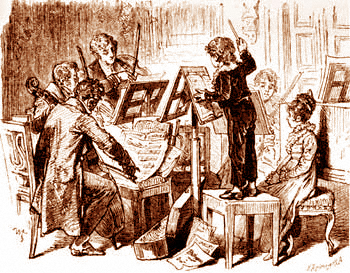PIECE: "ANDANTE" FROM VIOLIN CONCERTO IN E MINOR
SECTION 4.8
| "Andante" from Violin Concerto in E Minor |
Felix Mendelssohn (1809-1847), a renowned German composer, composed his Violin Concerto in E Minor in 1844. Mendelssohn was the son of a wealthy German banker, and was the grandson of the philosopher Moses Mendelssohn. He was raised in a highly cultured home, and Felix and his sister Fanny were both very gifted musically (they studied music with some of the leading musicians and composers in Berlin and Paris). Fanny and Felix often performed their music at Sunday morning musicales (concerts) held at the Mendelssohn home (they played the music of other composers too). Berlin's cultural élite, including many prominent musicians, attended these informal salon concerts. During some of these musicales, the Mendelssohn family even engaged a small orchestra for Felix to experiment with some of his musical ideas (by the age of 12, he had already written six symphonies).
As a side note, although Fanny was a gifted musician and composer like her brother, her family discouraged her from performing in public or publishing her music because they felt it was unsuitable for a woman to be a professional musician. When Fanny married, her husband Wilhem Hensel encouraged her to publish her music, and Fanny published a small amount of her compositions. Fanny wrote over 400 works, mostly piano music and lieder, and much of this music has never been published. Fanny and Felix remained close throughout their lives, and Felix often relied on her advice and support. [23]
Felix's friend, Robert Schumann, described Felix as the Mozart of the nineteenth century, and this description aptly applies because Felix wrote music that contained classical elements and refinement, combined with the warmth, lyricism and expressiveness of Romanticism. Felix composed in most of the major musical forms of his day, and he developed an international reputation, not only for his compositions, but also for his conducting. In 1835, Felix moved to Leipzig to become the conductor of the Leipzig Gewandhaus Orchestra, and he helped elevate the status of this group until it became one of the leading orchestras in Europe. While in Leipzig, he also founded the Leipzeig Conservatory, one of the most prominent European schools of music (it still is in existence today). [24]
Felix Mendelssohn wrote his Violin Concerto in E minor, Op. 64, for his friend Ferdinand David, a renowned violinist. It took Mendelssohn a number of years to compose, and he completed the violin concerto in 1844. It was first performed in 1845 by the Gewandhaus Orchestra with David as the soloist (David was the regular concertmaster of this group). The violin concerto was received with great acclaim at its first performance, and has since become one of the most popular violin concertos in violin literature. This piece has a typical concerto form of three movements: fast—slow—fast. One of the unique features of this piece is that Felix indicated it should be played without pause (concertos generally have a slight pause between movements), thus creating the effect of a seamless, unified musical work.
TECHNIQUE TIPS: This arrangement is based on the second movement of Mendelssohn's Violin Concerto in E minor. The heading of this movement is "Andante," a tempo that means a moderately slow tempo (often considered to be a walking speed). The melody has an intimate, songlike feel, and like many slow movements of concertos, this movement is structured in an A-B-A form (theme A is found in measures 1-18; theme B in measures 19-26; and theme A returns in measures 27-end).
© Copyright 2024 RK Deverich. All rights reserved.
*Although this online viola class is provided free of charge, all rights are reserved and this content is protected by international copyright law. It is illegal to copy, post or publish this content in any form, and displaying any of this material on other websites, blogs or feeds is prohibited. Permission is given for individual users to print pages from this website for their personal, non-commercial use.



